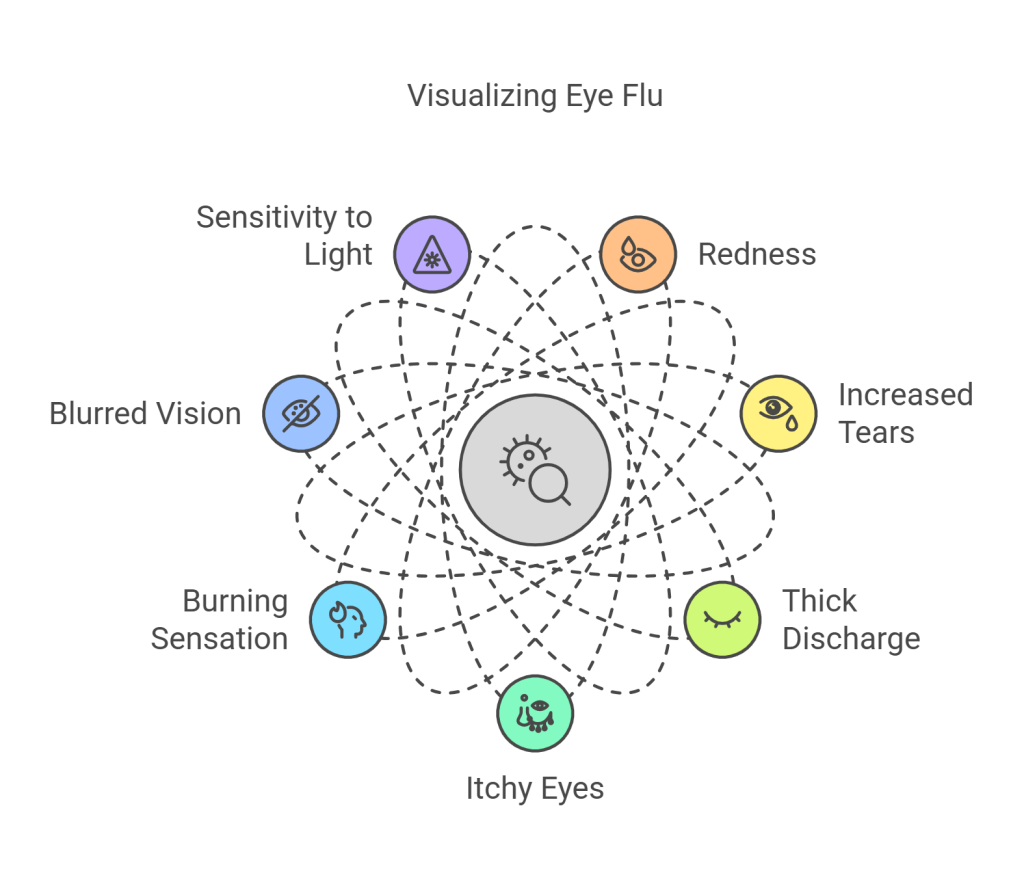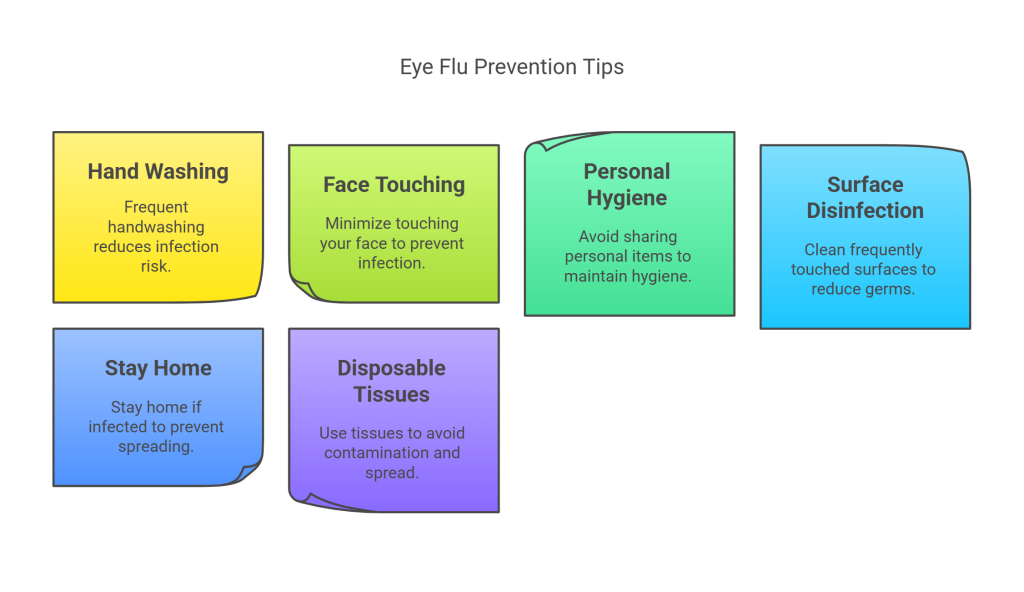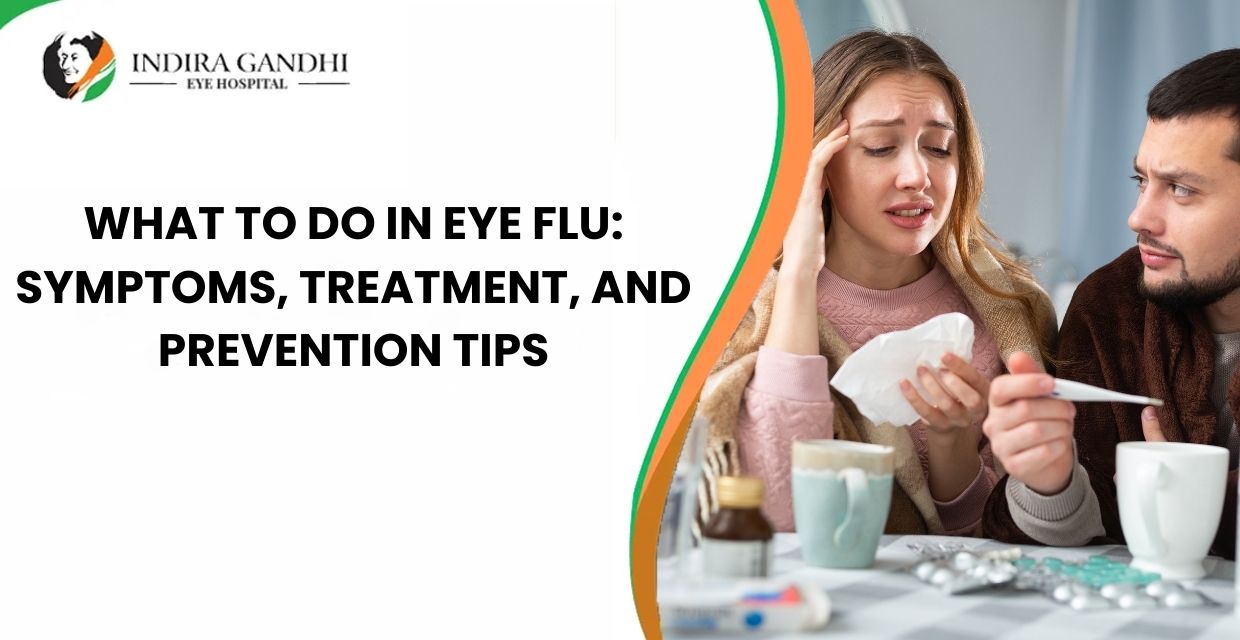|
Getting your Trinity Audio player ready...
|
Eye flu, more formally known as viral conjunctivitis, is a common condition that affects people of all ages, leading to red, irritated, and watery eyes. This contagious infection can cause significant discomfort but is typically self-limiting, meaning it often resolves without the need for medical treatment. However, understanding the symptoms, seeking appropriate treatment, and following preventive measures can significantly reduce the spread of infection and alleviate discomfort. Here’s everything you need to know about managing and preventing eye flu.
Understanding Eye Flu: Symptoms and Causes

Eye flu is primarily caused by adenoviruses, though other viruses such as herpes simplex can also lead to conjunctivitis. The infection spreads through direct contact with an infected person or by touching surfaces contaminated with the virus. The typical symptoms include:
- Redness in the white of the eye or inner eyelid
- Increased amount of tears
- Thick yellow discharge that crusts over the eyelashes, especially after sleep
- Itchy eyes
- Burning eyes
- Blurred vision
- Increased sensitivity to light
These symptoms can appear in one or both eyes, and while they are often mild, they can sometimes lead to more severe discomfort or visual problems.
Treatment Options for Eye Flu
Viral conjunctivitis usually resolves on its own within a week or two without the need for medical treatment. However, there are ways to alleviate the symptoms:
Home Remedies
- Apply a Cold Compress: Use a clean, damp cloth soaked in cold water and apply it to your eyes several times a day to reduce swelling and irritation.
- Maintain Good Hygiene: Regularly wash your hands with soap and water, especially after touching your eyes. Avoid sharing towels, washcloths, or eye cosmetics.
- Avoid Contact Lenses: Switch to glasses temporarily to avoid further irritation and reduce the risk of spreading the infection.
Medical Treatments
While antibiotics do not treat viral infections, there are cases where secondary bacterial infections may require prescription eye drops or ointments. Always consult with a healthcare professional if symptoms worsen or persist beyond two weeks.
Preventing Eye Flu

Prevention is crucial in controlling the spread of eye flu. Here are some effective tips:
- Wash Hands Regularly: Frequent handwashing with soap and water for at least 20 seconds can significantly reduce the risk of spreading the infection.
- Avoid Touching Your Face: Try to reduce how often you touch your eyes, nose, and mouth with unwashed hands.
- Maintain Personal Hygiene Items: Do not share personal items such as towels, bedding, and eye cosmetics.
- Disinfect Surfaces: Regularly clean surfaces that are frequently touched, such as door handles, computer keyboards, and phones, especially if someone around you is infected.
- Stay Home if Sick: If you are infected with eye flu, staying home from work, school, or social activities until you no longer have symptoms can help prevent the spread to others.
- Use Disposable Tissues: Use tissues to wipe your eyes or nose and dispose of them immediately to prevent contamination of surfaces or spreading the virus to others.
When symptoms become severe or persistent, it is important to consult a healthcare provider, preferably at one of the Best Eye Hospitals in India, where specialized treatment and expert advice can be accessed.
Frequently Asked Questions About Eye Flu
What is the difference between viral and bacterial conjunctivitis?
Viral and bacterial conjunctivitis can look similar, but there are a few key differences:
- Viral Conjunctivitis: Typically causes watery discharge, is more common, and is highly contagious. It usually clears up on its own within one to two weeks.
- Bacterial Conjunctivitis: Often results in a heavy, yellow or greenish discharge that might make the eyelids stick together in the morning and can require antibiotic treatment.
Can eye flu affect vision permanently?
In most cases, eye flu does not cause any permanent damage to vision. However, severe infections, especially those not treated properly, can lead to complications that may affect vision. Always consult with an eye care professional if you experience any changes in vision during or after an episode of conjunctivitis.
How can I tell if my child has eye flu?
Children are particularly susceptible to conjunctivitis due to their close contact with others in schools and playgrounds. Symptoms in children are similar to adults, including redness, watering, and discharge from the eyes. Children may also exhibit additional symptoms like sensitivity to light or a gritty feeling in the eyes. If your child shows signs of eye flu, it is important to keep them home from school to prevent the spread of infection and consult a pediatrician.
How long is eye flu contagious?
Viral conjunctivitis is contagious as long as symptoms are present, and sometimes even before symptoms appear. It can spread easily, especially in crowded conditions. Therefore, it’s crucial to follow strict hygiene and quarantine measures until symptoms fully resolve to prevent transmission.
What should I do if I wear contact lenses and get eye flu?
If you develop eye flu while wearing contact lenses, stop using them immediately and switch to glasses until your symptoms completely disappear. This not only helps in reducing irritation but also prevents the condition from worsening. Also, replace your lenses and lens case after the infection has cleared, as they could be contaminated.
Can eye makeup cause eye flu?
While eye makeup itself cannot cause viral conjunctivitis, using contaminated eye makeup can. If you develop eye flu, discard any eye makeup you were using as it could be infected. Avoid sharing eye makeup to prevent the spread of the infection.
Are there any complications associated with eye flu?
Complications from eye flu are rare, but they can occur, especially if the condition is not treated properly or if hygiene practices are not followed. Complications may include keratitis (an inflammation of the cornea), which can lead to ulcers and in severe cases, can threaten vision. If you experience intense pain, vision changes, or symptoms that do not improve, see a healthcare provider immediately.
Conclusion
Eye flu, though uncomfortable and highly contagious, is generally a self-limiting condition that improves with minimal treatment. Understanding the symptoms, applying the right treatment methods, and adhering to preventive measures can significantly ease the experience and prevent the spread of the infection. Practicing good hygiene, being mindful of the symptoms, and consulting with a healthcare professional when necessary are key steps in managing and recovering from eye flu.
By following these guidelines, you can ensure that you and those around you are protected from this uncomfortable yet manageable eye condition. Whether it’s maintaining personal hygiene, using medications appropriately, or knowing when to seek medical help, being informed is your best defense against eye flu.












